A Field Study to Investigate the Hydrological Characteristics of Newly Established Biochar-Amended Green Roofs
Abstract
:1. Introduction
2. Method and Materials
2.1. Site Description
2.2. Biochar Selection
2.3. Rainfall Simulation
2.4. Data Collection and Analysis
3. Results
3.1. Runoff Retention
3.2. Runoff Outflow Delay
4. Discussion
4.1. Biochar Variables: Application Method, Amendment Rate, and Particle Size
4.2. The Influences of Rainfall Depth, Climate Conditions, and Other Factors
5. Conclusions
- (a)
- Green Roofs (GRs) amended with biochar outperformed conventional GRs in terms of rainfall retention and runoff outflow delays.
- (b)
- This study recommends biochar amendment rate of up to 7.5% v/v, as an increased biochar amount to 15% v/v did not lead to a noticeable improvement. The 7.5% v/v dose is reasonable considering the hydrological performance, biochar costs, and currently limited availability of biochar.
- (c)
- This study suggests the application of biochar in the bottom layer of the substrate as the optimal method due to high water retention, long outflow delay, fast drainage, and less biochar loss.
- (d)
- Applying biochar with water on the surface of GR substrates is the most appropriate method in cases of failed/well-established GRs, where other methods are impractical.
- (e)
- Medium biochar particles are recommended to be used in future GR systems. It was observed that fine particles cause substrate waterlogging and biochar loss to the environment, whereas large particles reduce the rainfall retention rate and runoff outflow delay.
- (f)
- More research is required to properly understand the impacts of initial soil moisture content, antecedent dry weather period (ADWP), and other parameters on the hydrological performance of GRs.
- (g)
- Further investigations are recommended to simultaneously study different biochar variables such as particle sizes and application methods to find out the optimal biochar-amended GR design.
Author Contributions
Funding
Data Availability Statement
Acknowledgments
Conflicts of Interest
References
- Versini, P.-A.; Gires, A.; Tchiguirinskaia, I.; Schertzer, D. Fractal analysis of green roof spatial implementation in European cities. Urban For. Urban Green. 2020, 49, 126629. [Google Scholar] [CrossRef]
- Zhang, G.; He, B.-J. Towards green roof implementation: Drivers, motivations, barriers and recommendations. Urban For. Urban Green. 2021, 58, 126992. [Google Scholar] [CrossRef]
- Manso, M.; Teotónio, I.; Silva, C.M.; Cruz, C.O. Green roof and green wall benefits and costs: A review of the quantitative evidence. Renew. Sustain. Energy Rev. 2021, 135, 110111. [Google Scholar] [CrossRef]
- Ávila-Hernández, A.; Simá, E.; Xamán, J.; Hernández-Pérez, I.; Téllez-Velázquez, E.; Chagolla-Aranda, M. Test box experiment and simulations of a green-roof: Thermal and energy performance of a residential building standard for Mexico. Energy Build. 2020, 209, 109709. [Google Scholar] [CrossRef]
- Sun, T.; Bou-Zeid, E.; Wang, Z.-H.; Zerba, E.; Ni, G.-H. Hydrometeorological determinants of green roof performance via a vertically-resolved model for heat and water transport. Build. Environ. 2013, 60, 211–224. [Google Scholar] [CrossRef]
- Gong, Y.; Yin, D.; Li, J.; Zhang, X.; Wang, W.; Fang, X.; Shi, H.; Wang, Q. Performance assessment of extensive green roof runoff flow and quality control capacity based on pilot experiments. Sci. Total Environ. 2019, 687, 505–515. [Google Scholar] [CrossRef]
- Tabatabaee, S.; Mahdiyar, A.; Durdyev, S.; Mohandes, S.R.; Ismail, S. An assessment model of benefits, opportunities, costs, and risks of green roof installation: A multi criteria decision making approach. J. Clean. Prod. 2019, 238, 117956. [Google Scholar] [CrossRef]
- Scolaro, T.P.; Ghisi, E. Life cycle assessment of green roofs: A literature review of layers materials and purposes. Sci. Total Environ. 2022, 829, 154650. [Google Scholar] [CrossRef] [PubMed]
- Cascone, S. Green roof design: State of the art on technology and materials. Sustainability 2019, 11, 3020. [Google Scholar] [CrossRef]
- Nguyen, C.N.; Muttil, N.; Tariq, M.A.U.R.; Ng, A.W. Quantifying the Benefits and Ecosystem Services Provided by Green Roofs—A Review. Water 2021, 14, 68. [Google Scholar] [CrossRef]
- Shafique, M.; Kim, R.; Rafiq, M. Green roof benefits, opportunities and challenges–A review. Renew. Sustain. Energy Rev. 2018, 90, 757–773. [Google Scholar] [CrossRef]
- Vijayaraghavan, K. Green roofs: A critical review on the role of components, benefits, limitations and trends. Renew. Sustain. Energy Rev. 2016, 57, 740–752. [Google Scholar] [CrossRef]
- Mahdiyar, A.; Mohandes, S.R.; Durdyev, S.; Tabatabaee, S.; Ismail, S. Barriers to green roof installation: An integrated fuzzy-based MCDM approach. J. Clean. Prod. 2020, 269, 122365. [Google Scholar] [CrossRef]
- Palermo, S.A.; Turco, M.; Principato, F.; Piro, P. Hydrological effectiveness of an extensive green roof in Mediterranean climate. Water 2019, 11, 1378. [Google Scholar] [CrossRef]
- Cipolla, S.S.; Maglionico, M.; Stojkov, I. A long-term hydrological modelling of an extensive green roof by means of SWMM. Ecol. Eng. 2016, 95, 876–887. [Google Scholar] [CrossRef]
- Versini, P.-A.; Ramier, D.; Berthier, E.; De Gouvello, B. Assessment of the hydrological impacts of green roof: From building scale to basin scale. J. Hydrol. 2015, 524, 562–575. [Google Scholar] [CrossRef]
- Yang, W.-Y.; Li, D.; Sun, T.; Ni, G.-H. Saturation-excess and infiltration-excess runoff on green roofs. Ecol. Eng. 2015, 74, 327–336. [Google Scholar] [CrossRef]
- Nawaz, R.; McDonald, A.; Postoyko, S. Hydrological performance of a full-scale extensive green roof located in a temperate climate. Ecol. Eng. 2015, 82, 66–80. [Google Scholar] [CrossRef]
- Wong, G.K.; Jim, C.Y. Quantitative hydrologic performance of extensive green roof under humid-tropical rainfall regime. Ecol. Eng. 2014, 70, 366–378. [Google Scholar] [CrossRef]
- Speak, A.; Rothwell, J.; Lindley, S.; Smith, C. Rainwater runoff retention on an aged intensive green roof. Sci. Total Environ. 2013, 461, 28–38. [Google Scholar] [CrossRef] [PubMed]
- Carson, T.; Marasco, D.; Culligan, P.; McGillis, W. Hydrological performance of extensive green roofs in New York City: Observations and multi-year modeling of three full-scale systems. Environ. Res. Lett. 2013, 8, 024036. [Google Scholar] [CrossRef]
- Razzaghmanesh, M.; Beecham, S. The hydrological behaviour of extensive and intensive green roofs in a dry climate. Sci. Total Environ. 2014, 499, 284–296. [Google Scholar] [CrossRef] [PubMed]
- Stovin, V.; Vesuviano, G.; Kasmin, H. The hydrological performance of a green roof test bed under UK climatic conditions. J. Hydrol. 2012, 414, 148–161. [Google Scholar] [CrossRef]
- Zhang, Q.; Miao, L.; Wang, X.; Liu, D.; Zhu, L.; Zhou, B.; Sun, J.; Liu, J. The capacity of greening roof to reduce stormwater runoff and pollution. Landsc. Urban Plan. 2015, 144, 142–150. [Google Scholar] [CrossRef]
- Zhang, Z.; Szota, C.; Fletcher, T.D.; Williams, N.S.; Farrell, C. Green roof storage capacity can be more important than evapotranspiration for retention performance. J. Environ. Manag. 2019, 232, 404–412. [Google Scholar] [CrossRef] [PubMed]
- Ferrans, P.; Rey, C.V.; Pérez, G.; Rodríguez, J.P.; Díaz-Granados, M. Effect of green roof configuration and hydrological variables on runoff water quantity and quality. Water 2018, 10, 960. [Google Scholar] [CrossRef]
- Zhang, Z.; Szota, C.; Fletcher, T.D.; Williams, N.S.; Werdin, J.; Farrell, C. Influence of plant composition and water use strategies on green roof stormwater retention. Sci. Total Environ. 2018, 625, 775–781. [Google Scholar] [CrossRef] [PubMed]
- Johannessen, B.G.; Muthanna, T.M.; Braskerud, B.C. Detention and retention behavior of four extensive green roofs in three nordic climate zones. Water 2018, 10, 671. [Google Scholar] [CrossRef]
- Soulis, K.X.; Valiantzas, J.D.; Ntoulas, N.; Kargas, G.; Nektarios, P.A. Simulation of green roof runoff under different substrate depths and vegetation covers by coupling a simple conceptual and a physically based hydrological model. J. Environ. Manag. 2017, 200, 434–445. [Google Scholar] [CrossRef]
- Gregoire, B.G.; Clausen, J.C. Effect of a modular extensive green roof on stormwater runoff and water quality. Ecol. Eng. 2011, 37, 963–969. [Google Scholar] [CrossRef]
- Hakimdavar, R.; Culligan, P.J.; Finazzi, M.; Barontini, S.; Ranzi, R. Scale dynamics of extensive green roofs: Quantifying the effect of drainage area and rainfall characteristics on observed and modeled green roof hydrologic performance. Ecol. Eng. 2014, 73, 494–508. [Google Scholar] [CrossRef]
- Kaiser, D.; Köhler, M.; Schmidt, M.; Wolff, F. Increasing evapotranspiration on extensive green roofs by changing substrate depths, construction, and additional irrigation. Buildings 2019, 9, 173. [Google Scholar] [CrossRef]
- Todorov, D.; Driscoll, C.T.; Todorova, S. Long-term and seasonal hydrologic performance of an extensive green roof. Hydrol. Process. 2018, 32, 2471–2482. [Google Scholar] [CrossRef]
- Carpenter, C.M.; Todorov, D.; Driscoll, C.T.; Montesdeoca, M. Water quantity and quality response of a green roof to storm events: Experimental and monitoring observations. Environ. Pollut. 2016, 218, 664–672. [Google Scholar] [CrossRef]
- Beecham, S.; Razzaghmanesh, M. Water quality and quantity investigation of green roofs in a dry climate. Water Res. 2015, 70, 370–384. [Google Scholar] [CrossRef]
- La Roche, P.; Yeom, D.J.; Ponce, A. Passive cooling with a hybrid green roof for extreme climates. Energy Build. 2020, 224, 110243. [Google Scholar] [CrossRef]
- Hui, S.C.; Chan, S.-C. Integration of green roof and solar photovoltaic systems. In Proceedings of the Joint symposium 2011: Integrated Building Design in the New Era of Sustainability, Kowloon Shangri-la Hotel, Tsim Sha Tsui East , Kowloon, Hong Kong, 22 November 2011; pp. 1–12. [Google Scholar]
- Chemisana, D.; Lamnatou, C. Photovoltaic-green roofs: An experimental evaluation of system performance. Appl. Energy 2014, 119, 246–256. [Google Scholar] [CrossRef]
- Kaewpraek, C.; Ali, L.; Rahman, M.A.; Shakeri, M.; Chowdhury, M.; Jamal, M.; Mia, M.S.; Pasupuleti, J.; Dong, L.K.; Techato, K. The effect of plants on the energy output of green roof photovoltaic systems in tropical climates. Sustainability 2021, 13, 4505. [Google Scholar] [CrossRef]
- Zheng, Y.; Weng, Q. Modeling the effect of green roof systems and photovoltaic panels for building energy savings to mitigate climate change. Remote Sens. 2020, 12, 2402. [Google Scholar] [CrossRef]
- Hussain, R.; Ravi, K.; Garg, A. Influence of biochar on the soil water retention characteristics (SWRC): Potential application in geotechnical engineering structures. Soil Tillage Res. 2020, 204, 104713. [Google Scholar] [CrossRef]
- Kwapinski, W.; Byrne, C.M.; Kryachko, E.; Wolfram, P.; Adley, C.; Leahy, J.J.; Novotny, E.H.; Hayes, M.H. Biochar from biomass and waste. Waste Biomass Valorization 2010, 1, 177–189. [Google Scholar] [CrossRef]
- Wang, J.; Wang, S. Preparation, modification and environmental application of biochar: A review. J. Clean. Prod. 2019, 227, 1002–1022. [Google Scholar] [CrossRef]
- Rasa, K.; Heikkinen, J.; Hannula, M.; Arstila, K.; Kulju, S.; Hyväluoma, J. How and why does willow biochar increase a clay soil water retention capacity? Biomass Bioenergy 2018, 119, 346–353. [Google Scholar] [CrossRef]
- Kocsis, T.; Ringer, M.; Biró, B. Characteristics and applications of biochar in soil–plant systems: A short review of benefits and potential drawbacks. Appl. Sci. 2022, 12, 4051. [Google Scholar] [CrossRef]
- Dunkerley, D. The case for increased validation of rainfall simulation as a tool for researching runoff, soil erosion, and related processes. Catena 2021, 202, 105283. [Google Scholar] [CrossRef]
- Li, M.; Garg, A.; Huang, S.; Jiang, M.; Mei, G.; Liu, J.; Wang, H. Hydrological properties of biochar-amended expansive soil under dynamic water environment and biochar-amended soil’s application in green roofs. Acta Geophys. 2023, 1–11. [Google Scholar] [CrossRef]
- Beck, D.A.; Johnson, G.R.; Spolek, G.A. Amending greenroof soil with biochar to affect runoff water quantity and quality. Environ. Pollut. 2011, 159, 2111–2118. [Google Scholar] [CrossRef]
- Wang, H.; Zhang, K.; Gan, L.; Liu, J.; Mei, G. Expansive soil-biochar-root-water-bacteria interaction: Investigation on crack development, water management and plant growth in green infrastructure. Int. J. Damage Mech. 2021, 30, 595–617. [Google Scholar] [CrossRef]
- Farrell, C.; Cao, C.; Ang, X.; Rayner, J. Use of water-retention additives to improve performance of green roof substrates. In Proceedings of the XXIX International Horticultural Congress on Horticulture: Sustaining Lives, Livelihoods and Landscapes (IHC2014), Brisbane, Australia, 17–22 August 2014; pp. 271–278. [Google Scholar]
- D’Ambrosio, R.; Mobilia, M.; Khamidullin, I.F.; Longobardi, A.; Elizaryev, A.N. How substrate and drainage layer materials affect the hydrological performance of Green Roofs: CHEMFLO-2000 numerical investigation. In Proceedings of the International Conference on Computational Science and Its Applications, Cagliari, Italy, 13–16 September 2021; pp. 254–263. [Google Scholar]
- Valagussa, M.; Gatt, A.; Tosca, A.; Martinetti, L. Physical, chemical and hydraulic characterization of different green roof growing media. In Proceedings of the III International Symposium on Growing Media, Composting and Substrate Analysis, Milan, Italy, 24–28 June 2019; pp. 391–398. [Google Scholar]
- Goldschmidt, A.M. Biochar amendment of green roof substrate: Effect on vegetation, nutrient retention, and hydrologic performance. Ph.D. Thesis, University of Cincinnati, Cincinnati, OH, USA, 2018. [Google Scholar]
- Gan, L.; Garg, A.; Huang, S.; Wang, J.; Mei, G.; Zhang, K. Experimental and numerical investigation on rainwater management of dual substrate layer green roofs using biochar-amended soil. Biomass Convers. Biorefin. 2022, 1–10. [Google Scholar] [CrossRef]
- Gan, L.; Garg, A.; Wang, H.; Mei, G.; Liu, J. Influence of biochar amendment on stormwater management in green roofs: Experiment with numerical investigation. Acta Geophys. 2021, 69, 2417–2426. [Google Scholar] [CrossRef]
- Liao, W.; Drake, J.; Thomas, S.C. Biochar granulation, particle size, and vegetation effects on leachate water quality from a green roof substrate. J. Environ. Manag. 2022, 318, 115506. [Google Scholar] [CrossRef]
- Wang, H.; Garg, A.; Zhang, X.; Xiao, Y.; Mei, G. Utilization of coconut shell residual in green roof: Hydraulic and thermal properties of expansive soil amended with biochar and fibre including theoretical model. Acta Geophys. 2020, 68, 1803–1819. [Google Scholar] [CrossRef]
- Werdin, J.; Conn, R.; Fletcher, T.D.; Rayner, J.P.; Williams, N.S.; Farrell, C. Biochar particle size and amendment rate are more important for water retention and weight of green roof substrates than differences in feedstock type. Ecol. Eng. 2021, 171, 106391. [Google Scholar] [CrossRef]
- Seitz, S.; Teuber, S.; Geißler, C.; Goebes, P.; Scholten, T. How Do Newly-Amended Biochar Particles Affect Erodibility and Soil Water Movement?—A Small-Scale Experimental Approach. Soil Syst. 2020, 4, 60. [Google Scholar] [CrossRef]
- Liao, W.; Drake, J.; Thomas, S.C. Biochar granulation enhances plant performance on a green roof substrate. Sci. Total Environ. 2022, 813, 152638. [Google Scholar] [CrossRef]
- Omondi, M.O.; Xia, X.; Nahayo, A.; Liu, X.; Korai, P.K.; Pan, G. Quantification of biochar effects on soil hydrological properties using meta-analysis of literature data. Geoderma 2016, 274, 28–34. [Google Scholar] [CrossRef]
- Huang, S.; Garg, A.; Mei, G.; Huang, D.; Chandra, R.B.; Sadasiv, S.G. Experimental study on the hydrological performance of green roofs in the application of novel biochar. Hydrol. Process. 2020, 34, 4512–4525. [Google Scholar] [CrossRef]
- Wang, H.; Garg, A.; Huang, S.; Mei, G. Mechanism of compacted biochar-amended expansive clay subjected to drying–wetting cycles: Simultaneous investigation of hydraulic and mechanical properties. Acta Geophys. 2020, 68, 737–749. [Google Scholar] [CrossRef]
- Cai, W.; Huang, H.; Chen, P.; Huang, X.; Gaurav, S.; Pan, Z.; Lin, P. Effects of biochar from invasive weed on soil erosion under varying compaction and slope conditions: Comprehensive study using flume experiments. Biomass Convers. Biorefinery 2020, 1–20. [Google Scholar] [CrossRef]
- Zhu, Y. Can Hydrological Function and Vegetation Cover of Failed Green Roofs Be Restored with Wood-Waste-Derived Biochar? Master’s Thesis, University of Toronto, Toronto, ON, Canada, 2020. Available online: https://hdl.handle.net/1807/99102 (accessed on 26 May 2023).
- Kuoppamäki, K.; Setälä, H.; Hagner, M. Nutrient dynamics and development of soil fauna in vegetated roofs with the focus on biochar amendment. Nat. Based Solut. 2021, 1, 100001. [Google Scholar] [CrossRef]
- Kuoppamäki, K.; Hagner, M.; Lehvävirta, S.; Setälä, H. Biochar amendment in the green roof substrate affects runoff quality and quantity. Ecol. Eng. 2016, 88, 1–9. [Google Scholar] [CrossRef]
- Ricks, M.D.; Horne, M.A.; Faulkner, B.; Zech, W.C.; Fang, X.; Donald, W.N.; Perez, M.A. Design of a pressurized rainfall simulator for evaluating performance of erosion control practices. Water 2019, 11, 2386. [Google Scholar] [CrossRef]
- Carvalho, S.C.; de Lima, J.L.; de Lima, M.I.P. Increasing the rainfall kinetic energy of spray nozzles by using meshes. Land Degrad. Dev. 2016, 27, 1295–1302. [Google Scholar] [CrossRef]
- Blanquies, J.; Scharff, M.; Hallock, B. The design and construction of a rainfall simulator. In Proceedings of the International Erosion Control Association (IECA), 34th Annual Conference and Expo, Las Vegas, NV, USA, 24–28 February 2003. [Google Scholar]
- Holko, L.; Lichner, Ľ.; Kollár, J.; Šurda, P.; Danko, M.; Zvala, A.; Kidron, G.J. Runoff response of a hydrophobic soil under high intensity rains. Hydrol. Process. 2023, 37, e14899. [Google Scholar] [CrossRef]
- Dunkerley, D. Rain event properties in nature and in rainfall simulation experiments: A comparative review with recommendations for increasingly systematic study and reporting. Hydrol. Process. Int. J. 2008, 22, 4415–4435. [Google Scholar] [CrossRef]
- Jahanfar, A.; Drake, J.; Sleep, B.; Margolis, L. Evaluating the shading effect of photovoltaic panels on green roof discharge reduction and plant growth. J. Hydrol. 2019, 568, 919–928. [Google Scholar] [CrossRef]
- Kuppusamy, S.; Thavamani, P.; Megharaj, M.; Venkateswarlu, K.; Naidu, R. Agronomic and remedial benefits and risks of applying biochar to soil: Current knowledge and future research directions. Environ. Int. 2016, 87, 1–12. [Google Scholar] [CrossRef] [PubMed]
- Piscitelli, L.; Rivier, P.-A.; Mondelli, D.; Miano, T.; Joner, E.J. Assessment of addition of biochar to filtering mixtures for potential water pollutant removal. Environ. Sci. Pollut. Res. 2018, 25, 2167–2174. [Google Scholar] [CrossRef] [PubMed]
- Liao, W.; Sifton, M.A.; Thomas, S.C. Biochar granulation reduces substrate erosion on green roofs. Biochar 2022, 4, 61. [Google Scholar] [CrossRef] [PubMed]
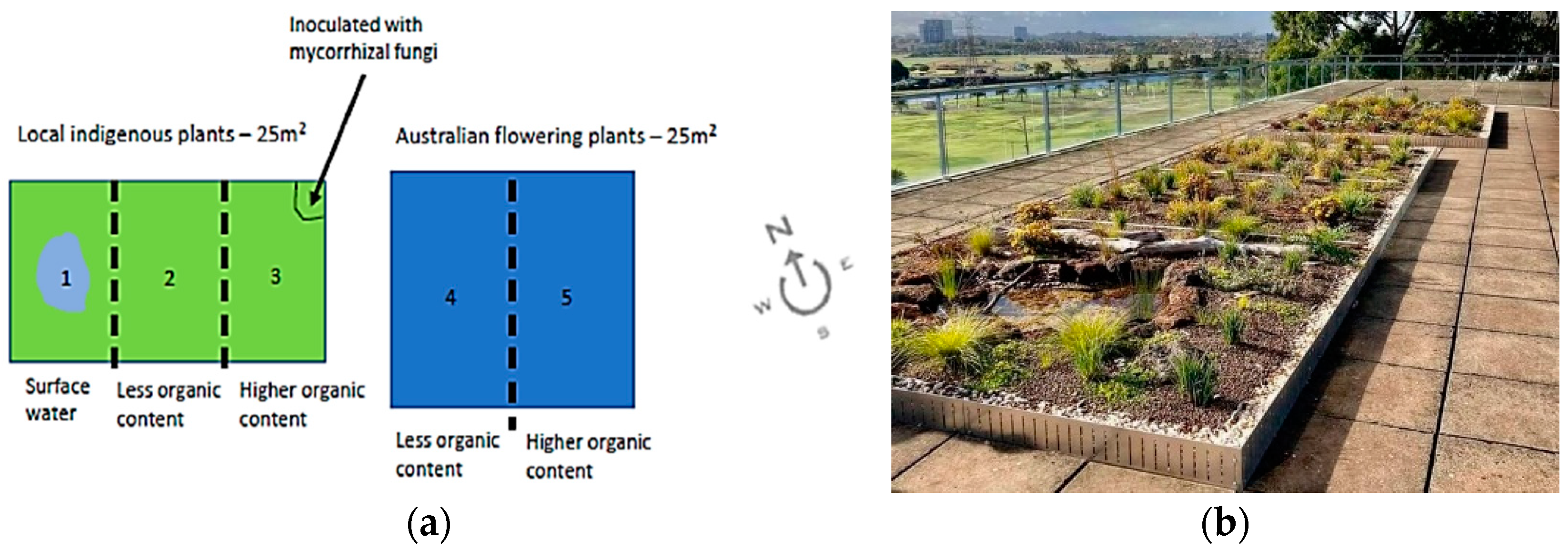
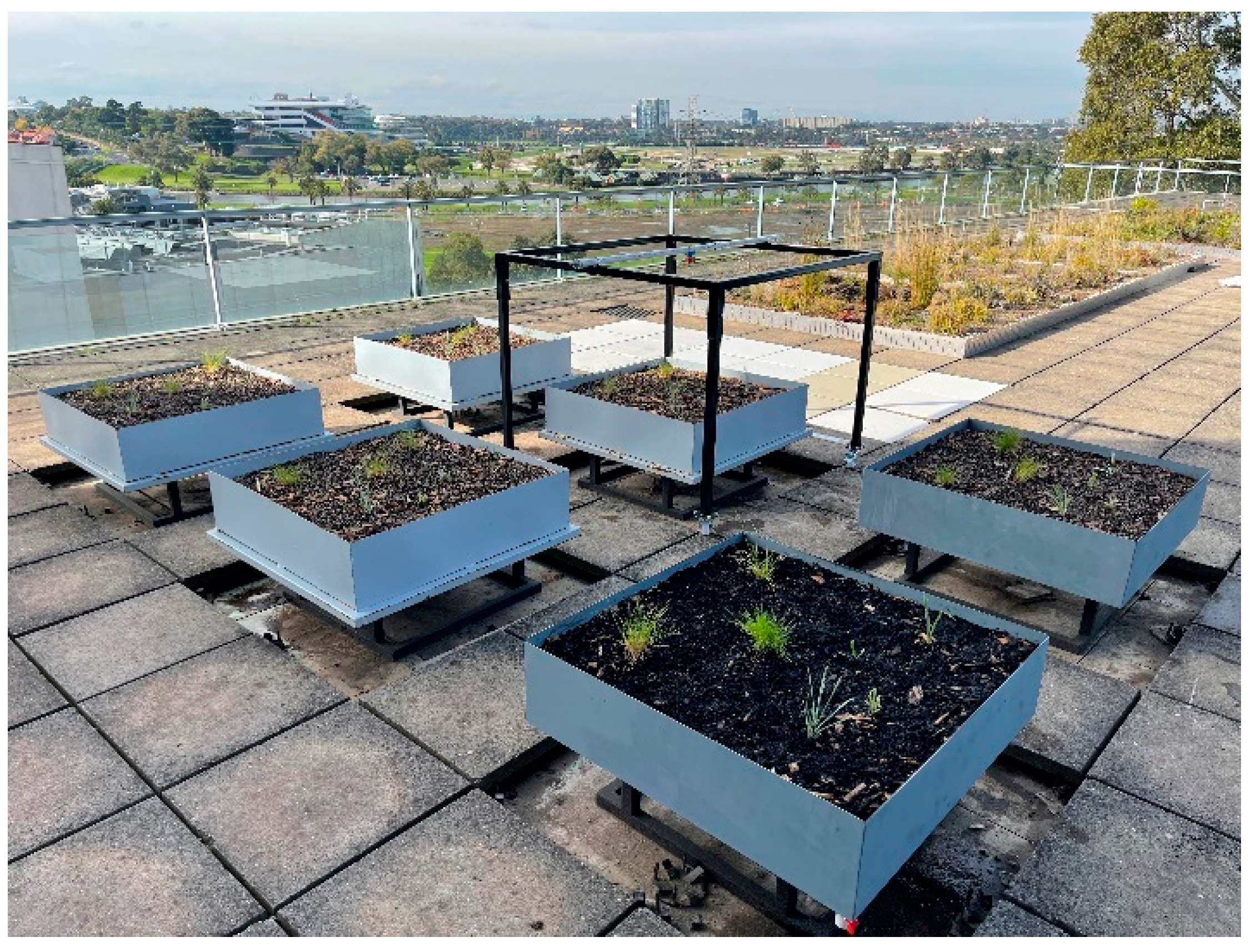
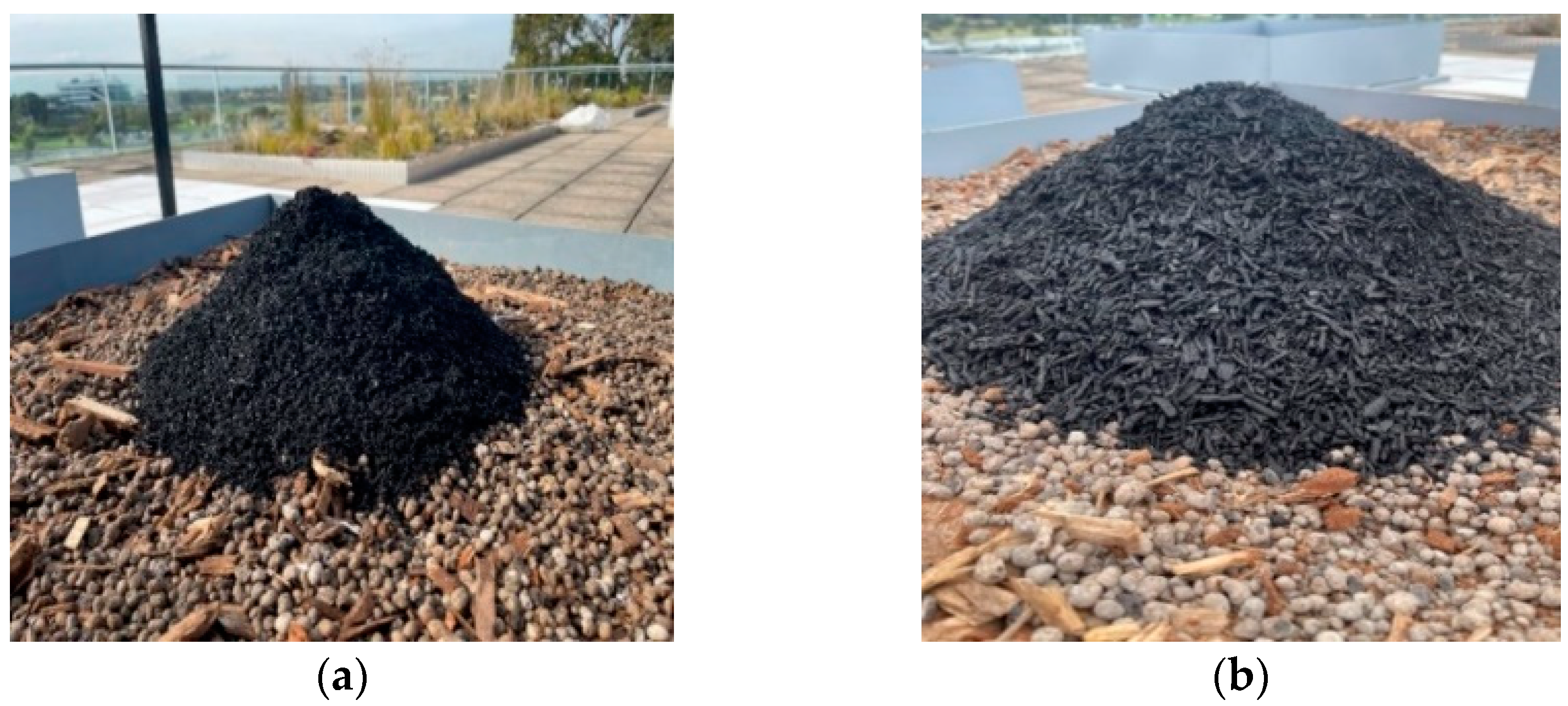
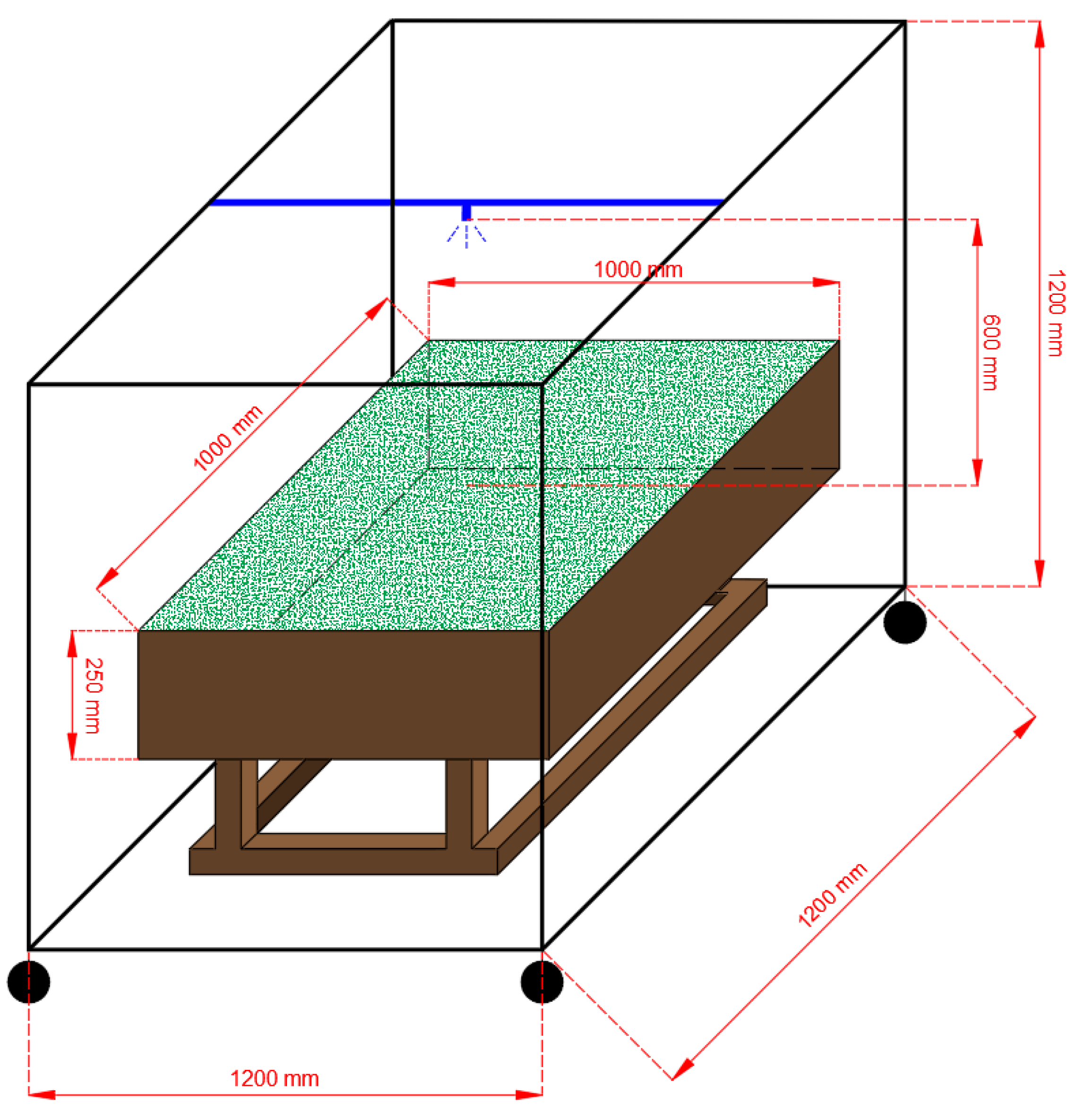

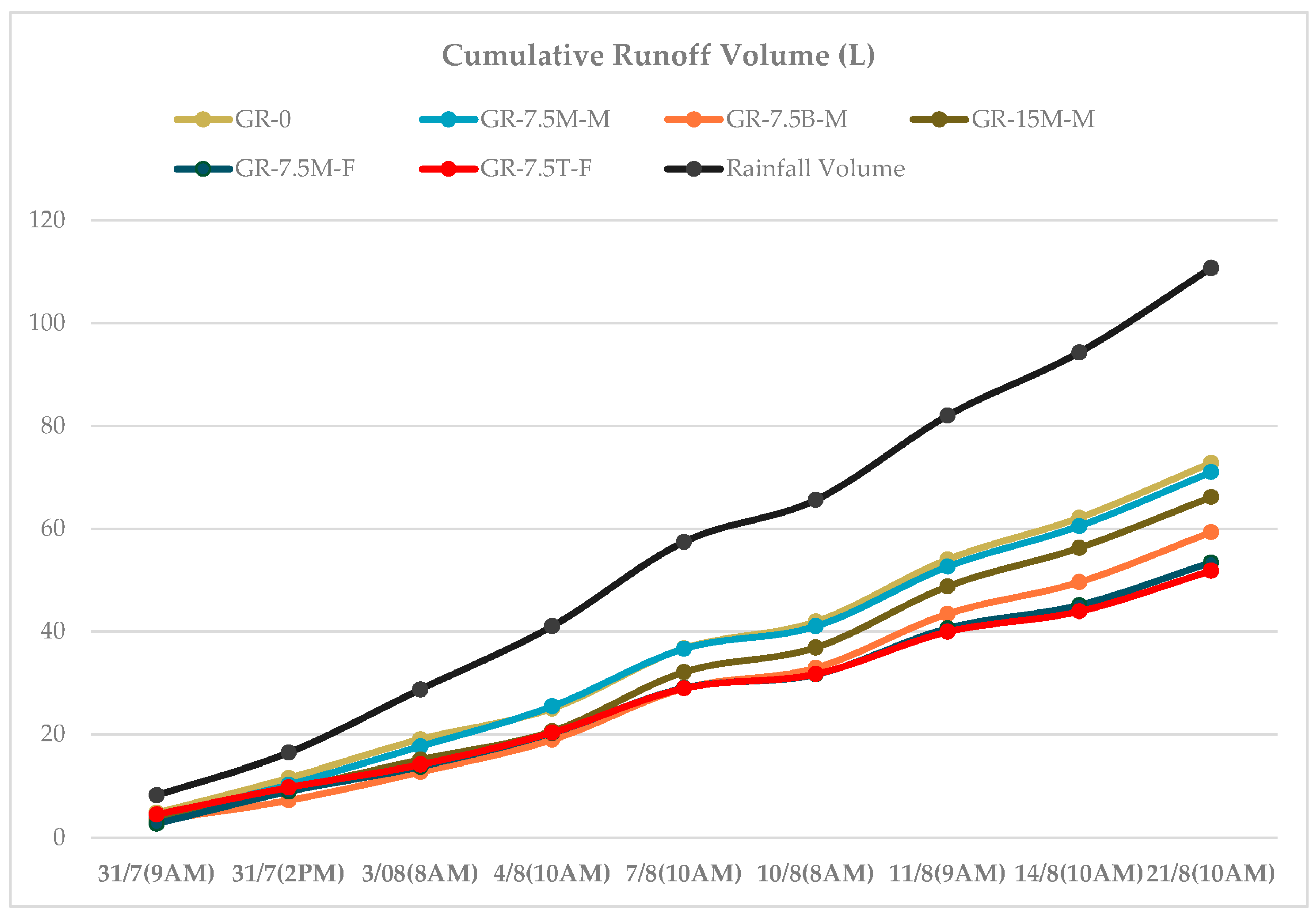
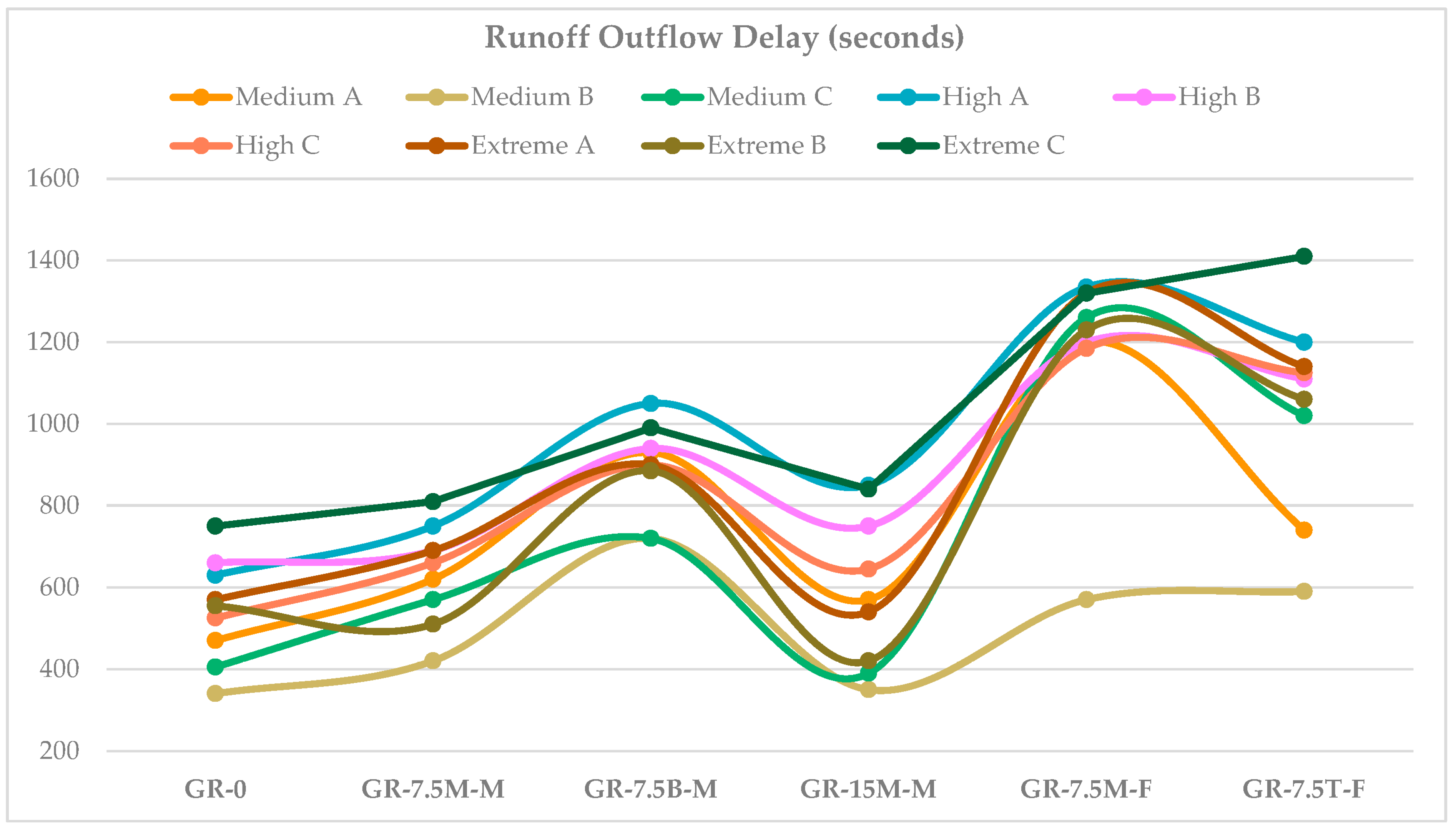

| GR Test Bed | Biochar Amendment Rate (%) | Biochar Application Method | Biochar Particle Size |
|---|---|---|---|
| GR-0 | 0 | NA | NA |
| GR-7.5M-M | 7.5 | Mixed | Medium |
| GR-7.5B-M | 7.5 | Bottom Layer | Medium |
| GR-15M-M | 15 | Mixed | Medium |
| GR-7.5M-F | 7.5 | Mixed | Fine |
| GR-7.5T-F | 7.5 | Top Dressing with Water | Fine |
| Event | Date (Time) | Simulation Runtime (min) | Estimated Rainfall Depth (mm) | Antecedent Dry Weather Period (Days) | Previous Rainfall Depth (mm) |
|---|---|---|---|---|---|
| Medium A | 31 July 2023 (9 a.m.) | 10 | 8.2 | 0 | 3 |
| Medium B | 31 July 2023 (2 p.m.) | 10 | 8.2 | 0 | 8.2 |
| Medium C | 10 August 2023 (8 a.m.) | 10 | 8.2 | 0 | Light rain until 7AM * |
| High A | 3 August 2023 (8 a.m.) | 15 | 12.3 | 2 | 8.2 |
| High B | 4 August 2023 (10 a.m.) | 15 | 12.3 | 0 | 12.3 |
| High C | 14 August 2023 (11 a.m.) | 15 | 12.3 | 0 | 3.4 |
| Extreme A | 7 August 2023 (10 a.m.) | 20 | 16.4 | 2 | 12.3 |
| Extreme B | 11 August 2023 (9 a.m.) | 20 | 16.4 | 0 | 8.2 |
| Extreme C | 21 August 2023 (9 a.m.) | 20 | 16.4 | 2 | 5.4 |
| Event | Test Bed | Initial Soil Moisture (1 to 10) | Estimated Rainfall Volume (L) | Runoff Volume (L) | Runoff Retention (%) | Runoff Outflow Delay (s) |
|---|---|---|---|---|---|---|
| Medium A 31 July 2023 (9 a.m.) | GR-0 | 3 ± 1 | 8.2 | 4.8 | 41.46% | 470 |
| GR-7.5M-M | 5 ± 1 | 8.2 | 3.85 | 53.05% | 620 | |
| GR-7.5B-M | 5 ± 1 | 8.2 | 3.3 | 59.76% | 930 | |
| GR-15M-M | 8 ± 1 | 8.2 | 3.4 | 58.54% | 570 | |
| GR-7.5M-F | 10 ± 2 | 8.2 | 2.7 | 67.07% | 1200 | |
| GR-7.5T-F | 10 ± 2 | 8.2 | 4.5 | 45.12% | 740 | |
| Medium B 31 July 2023 (2 p.m.) | GR-0 | 5 ± 2 | 8.2 | 6.7 | 18.29% | 340 |
| GR-7.5M-M | 7 ± 2 | 8.2 | 6.4 | 21.95% | 420 | |
| GR-7.5B-M | 7 ± 2 | 8.2 | 3.9 | 52.44% | 720 | |
| GR-15M-M | 10 ± 2 | 8.2 | 5.9 | 28.05% | 350 | |
| GR-7.5M-F | 15 ± 3 | 8.2 | 6.2 | 24.39% | 570 | |
| GR-7.5T-F | 12 ± 3 | 8.2 | 5.2 | 36.59% | 590 | |
| Medium C 10 August 2023 (8 a.m.) | GR-0 | 5 ± 1 | 8.2 | 5.2 | 36.59% | 405 |
| GR-7.5M-M | 5 ± 1 | 8.2 | 4.4 | 46.34% | 570 | |
| GR-7.5B-M | 5 ± 1 | 8.2 | 4 | 51.22% | 720 | |
| GR-15M-M | 7 ± 2 | 8.2 | 4.8 | 41.46% | 390 | |
| GR-7.5M-F | 10 ± 1 | 8.2 | 2.6 | 68.29% | 1260 | |
| GR-7.5T-F | 8 ± 2 | 8.2 | 2.8 | 65.85% | 1020 | |
| High A 3 August 2023 (8 a.m.) | GR-0 | 2 ± 1 | 12.3 | 7.5 | 39.02% | 630 |
| GR-7.5M-M | 3 ± 1 | 12.3 | 7.35 | 40.24% | 750 | |
| GR-7.5B-M | 5 ± 1 | 12.3 | 5.5 | 55.28% | 1050 | |
| GR-15M-M | 5 ± 2 | 12.3 | 5.75 | 53.25% | 850 | |
| GR-7.5M-F | 8 ± 2 | 12.3 | 4.8 | 60.98% | 1335 | |
| GR-7.5T-F | 8 ± 2 | 12.3 | 4.4 | 64.23% | 1200 | |
| High B 4 August 2023 (10 a.m.) | GR-0 | 2 ± 1 | 12.3 | 6 | 51.22% | 660 |
| GR-7.5M-M | 5 ± 1 | 12.3 | 7.8 | 36.59% | 690 | |
| GR-7.5B-M | 5 ± 1 | 12.3 | 6.2 | 49.59% | 940 | |
| GR-15M-M | 7 ± 2 | 12.3 | 5.5 | 55.28% | 750 | |
| GR-7.5M-F | 9 ± 2 | 12.3 | 6.5 | 47.15% | 1200 | |
| GR-7.5T-F | 8 ± 2 | 12.3 | 6.2 | 49.59% | 1110 | |
| High C 14 August 2023 (11 a.m.) | GR-0 | 4 ± 1 | 12.3 | 8.1 | 34.15% | 525 |
| GR-7.5M-M | 8 ± 1 | 12.3 | 7.9 | 35.77% | 660 | |
| GR-7.5B-M | 4 ± 1 | 12.3 | 6.2 | 49.59% | 900 | |
| GR-15M-M | 8 ± 1 | 12.3 | 7.5 | 39.02% | 645 | |
| GR-7.5M-F | 7 ± 1 | 12.3 | 4.5 | 63.41% | 1185 | |
| GR-7.5T-F | 5 ± 1 | 12.3 | 4 | 67.48% | 1125 | |
| Extreme A 7 August 2023 (10 a.m.) | GR-0 | 1 ± 1 | 16.4 | 11.7 | 28.66% | 570 |
| GR-7.5M-M | 1 ± 1 | 16.4 | 11.2 | 31.71% | 690 | |
| GR-7.5B-M | 4 ± 2 | 16.4 | 10 | 39.02% | 900 | |
| GR-15M-M | 5 ± 2 | 16.4 | 11.5 | 29.88% | 540 | |
| GR-7.5M-F | 8 ± 2 | 16.4 | 8.8 | 46.34% | 1320 | |
| GR-7.5T-F | 7 ± 2 | 16.4 | 8.6 | 47.56% | 1140 | |
| Extreme B 11 August 2023 (9 a.m.) | GR-0 | 3 ± 1 | 16.4 | 12.1 | 26.22% | 555 |
| GR-7.5M-M | 4 ± 1 | 16.4 | 11.6 | 29.27% | 510 | |
| GR-7.5B-M | 4 ± 1 | 16.4 | 10.5 | 35.98% | 885 | |
| GR-15M-M | 8 ± 2 | 16.4 | 11.9 | 27.44% | 420 | |
| GR-7.5M-F | 8 ± 2 | 16.4 | 9 | 45.12% | 1230 | |
| GR-7.5T-F | 7 ± 2 | 16.4 | 8.2 | 50.00% | 1060 | |
| Extreme C 21 August 2023 (9 a.m.) | GR-0 | 5 ± 1 | 16.4 | 10.7 | 34.76% | 750 |
| GR-7.5M-M | 4 ± 1 | 16.4 | 10.5 | 35.98% | 810 | |
| GR-7.5B-M | 5 ± 1 | 16.4 | 9.7 | 40.85% | 990 | |
| GR-15M-M | 6 ± 2 | 16.4 | 9.9 | 39.63% | 840 | |
| GR-7.5M-F | 7 ± 2 | 16.4 | 8.3 | 49.39% | 1320 | |
| GR-7.5T-F | 5 ± 1 | 16.4 | 7.9 | 51.83% | 1410 |
Disclaimer/Publisher’s Note: The statements, opinions and data contained in all publications are solely those of the individual author(s) and contributor(s) and not of MDPI and/or the editor(s). MDPI and/or the editor(s) disclaim responsibility for any injury to people or property resulting from any ideas, methods, instructions or products referred to in the content. |
© 2024 by the authors. Licensee MDPI, Basel, Switzerland. This article is an open access article distributed under the terms and conditions of the Creative Commons Attribution (CC BY) license (https://creativecommons.org/licenses/by/4.0/).
Share and Cite
Nguyen, C.N.; Chau, H.-W.; Muttil, N. A Field Study to Investigate the Hydrological Characteristics of Newly Established Biochar-Amended Green Roofs. Water 2024, 16, 482. https://doi.org/10.3390/w16030482
Nguyen CN, Chau H-W, Muttil N. A Field Study to Investigate the Hydrological Characteristics of Newly Established Biochar-Amended Green Roofs. Water. 2024; 16(3):482. https://doi.org/10.3390/w16030482
Chicago/Turabian StyleNguyen, Cuong Ngoc, Hing-Wah Chau, and Nitin Muttil. 2024. "A Field Study to Investigate the Hydrological Characteristics of Newly Established Biochar-Amended Green Roofs" Water 16, no. 3: 482. https://doi.org/10.3390/w16030482







